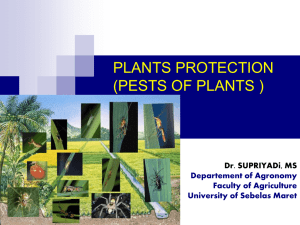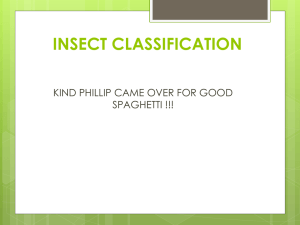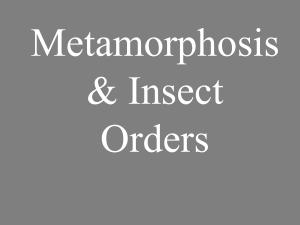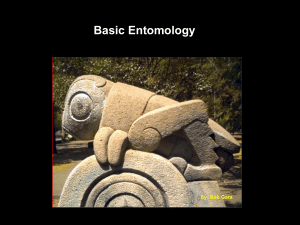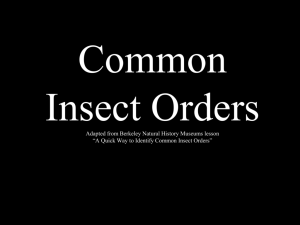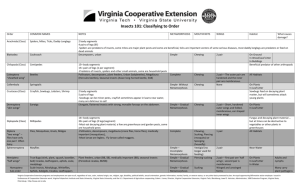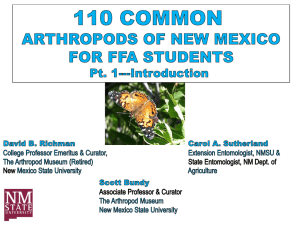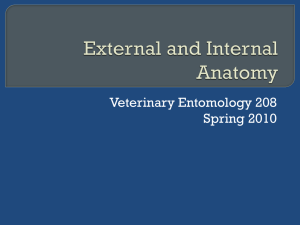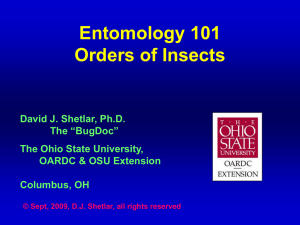Insect Classification
advertisement
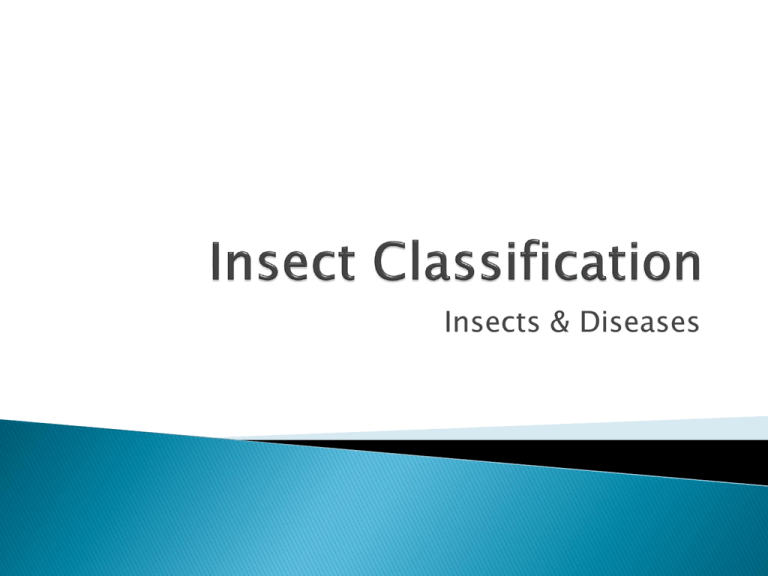
Insects & Diseases Remember the classification scheme? Kingdom Phylum Class > Order Family Genus Species Approximately 30 orders. Most are insignificant and are only studied for scientific purposes. Mites Ticks Spiders Mollusks (also spelled mollusc) ◦ Snails ◦ Slugs Largest number of species – 1 in 5 living creatures is a beetle! Mostly CHEWING MOUTHPARTS Complete Metamorphosis Two pairs of wings ◦ Front pair thick, hard, meet in a line ◦ Back pair membranous, used for flight Some of our best known pest species ◦ ◦ ◦ ◦ Japanese beetle white grub weevils rootworms Spot ID Chewing mouthparts Spot ID Chewing mouthparts Forewings (elytra) form hard shell covering hindwings Variable size Adults have 2 pairs of membranous wings covered with scales Antennae usually knobbed, thread-like, or feathery Complete metamorphosis Mouthparts ◦ Adults – lapping or sucking ◦ Larvae – chewing Coiling-sucking mouthparts Coiling-sucking mouthparts Four wings covered with scales Many familiar friends and foes in Lepidoptera: ◦ ◦ ◦ ◦ ◦ ◦ ◦ Caterpillars Butterflies Moths Cutworms Armyworms Borers Leafminers One pair of wings Halteres in place of hindwings Piercing, sucking, sponging mouthparts Complete metamorphosis Larvae known as maggots ◦ usually legless, many aquatic Important econ. pest, disease vectors Mosquitos, flies Mostly beneficials for hort. crops Spot ID Two wings Spot ID Two wings ◦ Hind wings reduced to halteres Spot ID Two wings ◦ Hind wings reduced to halteres Sponging-sucking mouthparts ◦ Except mosquitoes and some others that pierce skin Two pairs of wings or wingless Antennae with 10 or more segments Mouthparts chewing/lapping Complete metamorphosis Female ovipositor may be modified into stinger or saw-like structure Many are colonial Many harmful and beneficial species ◦ bees, wasps, ants, sawflies Hooks not shown Spot ID Chewing mouthparts Spot ID Chewing mouthparts Four membranous wings Spot ID Chewing mouthparts Four membranous wings Waist often constricted Spot ID Chewing mouthparts Four membranous wings Waist often constricted Females with ovipositor or stinger at end of abdomen Two pairs of wings usually present; flat over body when resting Forewings with the basal portion thickened and leathery and the wingtip membranous Hindwings entirely membranous Piercing, sucking beak Simple metamorphosis – juveniles (nymphs) resemble adults ◦ Chinch bugs ◦ Squash bugs ◦ Box elder bugs Spot ID A beak: piercing-sucking mouthparts Spot ID A beak: piercing-sucking mouthparts Forewings covering hindwings ◦ Wing half membrane, half thickened Some consider this a suborder of Hemiptera May or may not have wings Some with wings held tent-like Many are plant feeders Piercing/sucking beak Simple metamorphosis Some bear live offspring (viviparity) Can be very small Many important ornamental and greenhouse pests ◦ ◦ ◦ ◦ ◦ ◦ Aphids Whitefly Scale Leafhoppers Cicadas Mealybugs Diversity in Homoptera Class Insecta ◦ ◦ ◦ ◦ Order Order Order Order Dermaptera – earwigs Thrysanthoptera – thrips Neuroptera – lacewings, mantids, ect. Orthoptera – crickets, grasshoppers, roaches Class Diplopoda – Millipedes Class Chilopoda – Centipedes Class Archnida ◦ Order Acari Ticks Mites Phylum Mollusca Slugs Snails Managed in same ways as insects Spot ID Jumping hind legs Spot ID Jumping hind legs Some with ovipositor at hind end Spot ID Long skin-like hindwings folded under very short forewings Spot ID Long skin-like hindwings folded under very short forewings Pinchers off end of abdomen
